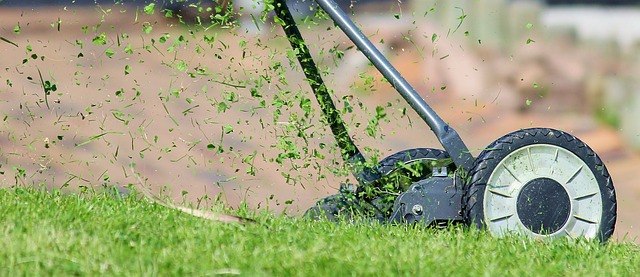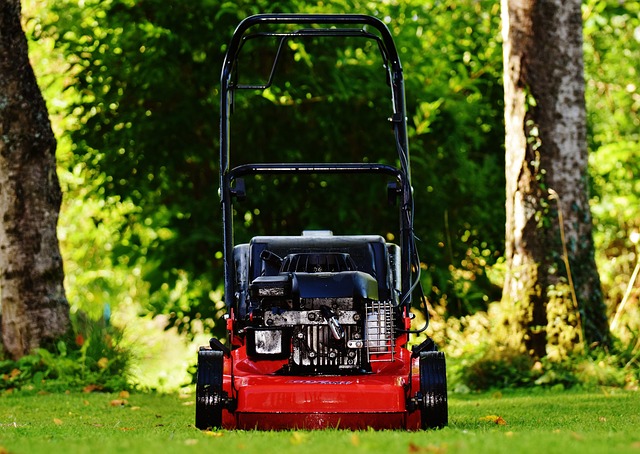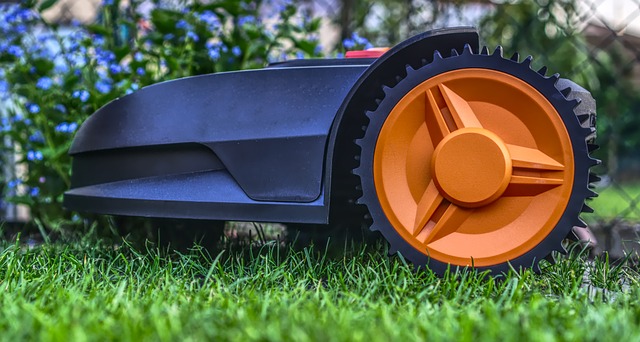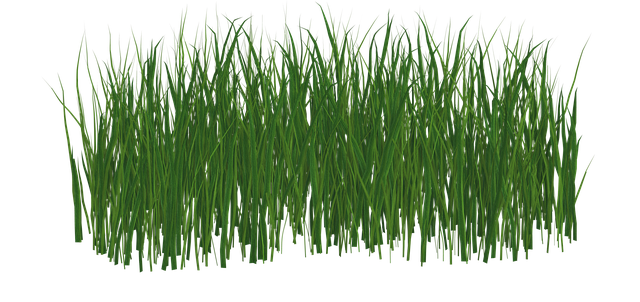embarking on a lawn remodeling project requires a thorough assessment of your lawn's existing conditions, including soil health, turf type, climate, and drainage. This evaluation is key to designing a personalized revitalization plan that addresses specific challenges and leverages local advantages for a sustainable and vibrant outdoor space. Selecting the right grass variety and hardscape features that complement your home and thrive in your region's environment is crucial. Incorporating smart irrigation systems and drought-resistant plants not only promotes water conservation but also contributes to an aesthetically pleasing and functional garden year-round. A strategic blend of vibrant plantings, well-planned hardscaping, and thoughtful outdoor lighting can transform your lawn into a serene retreat that enhances the beauty and value of your home while reflecting your personal style. This approach ensures a harmonious balance between design, functionality, and environmental sustainability in your garden remodel.
Embarking on a garden remodeling journey can transform your outdoor space into a tranquil oasis or a vibrant extension of your home. This article provides expert insights and guidance tailored to help you assess, plan, and execute a successful lawn renovation. We’ll explore the crucial steps in evaluating your current lawn condition, strategizing for optimal design and functionality, selecting suitable grass varieties for your climate and soil, implementing water-efficient irrigation systems, and incorporating garden features that enhance both beauty and utility. Whether you’re a novice gardener or an experienced horticulturist, these tips will ensure your garden remodeling project achieves the lawn of your dreams.
- Assessing Your Lawn's Current State: A Fundamental Step in Garden Remodeling
- Planning Your Dream Lawn: Strategic Design and Functionality Considerations
- Selecting the Right Turf for Your Climate and Soil Type: A Guide to Grass Varieties
- Implementing Water-Saving Irrigation Systems: Tips for Efficient Lawn Maintenance
- Enhancing Garden Aesthetics with Outdoor Features: From Flower Beds to Hardscaping Elements
Assessing Your Lawn's Current State: A Fundamental Step in Garden Remodeling

Beginning a garden remodeling project starts with a thorough assessment of your lawn’s current state. This foundational step is pivotal in determining the scope and direction of your renovation efforts. A detailed inspection will reveal existing conditions, such as soil health, turf type, drainage issues, and the presence of invasive species or lawn diseases that need to be addressed before introducing new elements to your garden. Understanding these factors allows for a tailored approach to revitalize your lawn, ensuring that the remediation measures align with your region’s specific climatic conditions and the particular needs of your grass variety. This not only sets the stage for a lush, vibrant lawn but also forms the basis for subsequent design decisions, such as selecting complementary plants, defining garden spaces, and integrating outdoor features that will coexist harmoniously with your revitalized turf.
Inventorying your lawn’s existing assets and challenges is an essential component of this initial evaluation. Utilize this opportunity to map out your lawn’s dimensions, noting areas that receive full sun or abundant shade, as well as identifying any uneven terrain or water pooling sites that could affect the health and beauty of your garden. This information will guide you in making informed decisions about which grass seed varieties are best suited for your space, what type of irrigation system would be most effective, and how to strategically place garden beds and pathways to enhance both aesthetics and functionality. By taking a methodical approach to assessing your lawn’s current state, you lay the groundwork for a successful garden remodeling project that will yield a beautiful and sustainable outdoor space.
Planning Your Dream Lawn: Strategic Design and Functionality Considerations

When embarking on a garden remodeling project that includes planning your dream lawn, careful consideration of both design and functionality is paramount. The layout should be meticulously planned to accommodate the specific needs of your space, taking into account soil type, sunlight exposure, and local climate conditions. Selecting the right grass variety for your region’s environment will ensure lush growth throughout the seasons. Additionally, integrating hardscape elements such as pathways or garden beds can enhance both the aesthetic appeal and usability of your lawn. By considering factors like traffic flow, water drainage, and maintenance requirements during the planning phase, you’ll be able to create a harmonious outdoor space that is both beautiful and practical.
Incorporating smart irrigation systems can further optimize the health and appearance of your lawn while conserving water. These systems use sensors to determine moisture levels and only activate sprinklers when necessary. Moreover, the strategic placement of plants and trees around your lawn can provide natural shade and windbreaks, reducing the need for extensive maintenance and fostering a more resilient green space. With careful planning and a focus on both design and function, your dream lawn will not only be a sanctuary for relaxation and play but also a testament to sustainable and thoughtful garden design.
Selecting the Right Turf for Your Climate and Soil Type: A Guide to Grass Varieties

When embarking on a garden remodeling project that includes refreshing your turf, choosing the right type of grass for your local climate and soil conditions is paramount. Climatic factors such as precipitation levels, humidity, temperature fluctuations, and sunlight exposure greatly influence the selection process. For instance, cool-season grasses like Kentucky bluegrass and fescues thrive in regions with moderate climates that experience cold winters and warm summers. Conversely, warm-season varieties like Bermuda grass and Zoysia are best suited for areas with hotter, more humid conditions, where they’ll flourish during the longer, warmer days of summer. Additionally, the soil type plays a crucial role in determining the optimal grass variety. Clay soils retain moisture well but may require aeration to prevent compaction, while sandy soils drain quickly and benefit from organic matter to improve water and nutrient retention. Acidic soils typically favor grasses like bluegrass, fescue, or ryegrass, whereas alkaline soils are more accommodating to Bermuda or St. Augustine grasses. Understanding these factors ensures that your lawn will not only look aesthetically pleasing but also be robust and resilient against the local environmental challenges.
Implementing Water-Saving Irrigation Systems: Tips for Efficient Lawn Maintenance

When revamping your garden with a focus on sustainability, implementing a water-saving irrigation system is a prudent choice. These systems not only conserve water but also contribute to cost savings and environmental responsibility. A key aspect of efficient lawn maintenance is selecting the appropriate irrigation technology for your garden’s size and terrain. For instance, drip irrigation or soaker hoses are excellent for targeting water delivery to specific areas where moisture is most needed, reducing runoff and water waste. Additionally, integrating a smart controller with weather sensor technology can adjust watering schedules based on real-time local climate conditions, ensuring your lawn receives only the necessary amount of water, neither more nor less.
To optimize your lawn’s health while minimizing water usage, consider the following tips: firstly, ensure that your irrigation system is free from leaks and malfunctions; these can significantly increase water consumption. Secondly, select turf varieties that are indigenous to your region and well-adapted to your local climate, as they often require less water to thrive. Lastly, regularly inspect and maintain your irrigation system to prevent overwatering, which can lead to waste and potentially harm your lawn. By carefully planning and implementing these strategies, you’ll create a lush, green lawn that is both beautiful and environmentally friendly.
Enhancing Garden Aesthetics with Outdoor Features: From Flower Beds to Hardscaping Elements

When contemplating a garden remodel, enhancing aesthetics is paramount. Strategic placement of flower beds can introduce vibrant splashes of color and fragrance that elevate the garden’s visual appeal throughout the seasons. Consider integrating a diverse selection of perennials and annuals to ensure year-round interest and maintain a lush, thriving landscape. Beyond floral arrangements, hardscaping elements such as pathways, water features, or outdoor seating areas can add character and definition to your garden space. These architectural touches not only complement the natural beauty of the plants but also serve functional purposes by guiding foot traffic and creating focal points that draw the eye. A well-designed lawn, with its smooth, green expanse, offers a harmonious canvas for these elements to stand out against, contributing to a cohesive and aesthetically pleasing outdoor environment.
Incorporating a variety of textures and materials in your hardscaping, such as natural stone or pavers, can introduce depth and visual interest to your garden. These elements can be tailored to your specific tastes and the scale of your garden, ensuring they blend seamlessly with the surrounding greenery. The integration of outdoor lighting is another aspect that should not be overlooked; it can highlight your garden’s features during evening hours, extending the enjoyment of your outdoor space and accentuating its design elements after dark. A thoughtfully planned lawn, complemented by carefully selected hardscaping components and accentuated with ambient lighting, will not only increase property value but also create an inviting and serene retreat that reflects your personal style and vision for your garden oasis.
Remodeling your garden into a lush, inviting space can be a transformative endeavor, and with expert guidance, it’s within reach. Begin by thoroughly assessing your lawn’s current condition to establish a solid foundation for your redesign. Next, envision the landscape you desire, considering both its aesthetic appeal and practical functionality. Choosing the optimal grass variety suited to your local climate and soil is crucial, ensuring a resilient and vibrant lawn. Implement water-saving irrigation systems to maintain this greenery efficiently, promoting sustainability and reducing water waste. Finally, enhance your garden’s beauty with strategic outdoor features that complement your new lawn, such as flower beds and hardscaping elements. With careful planning and the right professional advice, your dream garden awaits.
